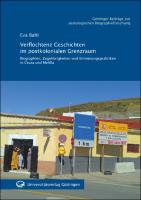Verflochtene Geschichten im postkolonialen Grenzraum
Biographien, Zugehörigkeiten und Erinnerungspraktiken in Ceuta und Melilla
Author(s)
Bahl, Eva
Collection
AG UniversitätsverlageLanguage
GermanAbstract
All over the world, borders are places of separation, distinction and violence on the one hand, and of encounter, mobility and everyday practices on the other. This is particularly true of the external borders of the European Union. When Spain joined the European Communities in 1986, Ceuta and Melilla, two cities in North Africa, became such an external border and the six-metre-high fences surrounding them became a symbol of “Fortress Europe”. But what does this mean for the people who live in such a place? How do they experience everyday life in a “caged city”, and how do they interpret their experiences?
This sociological study focuses on figurations between old-established groupings in the border space between Spain and Morocco, and reconstructs a post-colonial border space in the light of transformation processes and slowly changing power balances, in which belongings and views of history are constantly being renegotiated.
Different actors in the border space are studied from the perspective of figurational sociology, the sociology of memory and biographical research. Four detailed case analyses serve to illustrate the complexity of local social realities. These are embedded in historical and present-day social constellations in this border space between Spain and Morocco, and it is made clear that constructions of belonging and power relations in Ceuta and Melilla can only be understood in the context of colonial and post-colonial processes and events.
Keywords
border; flight; sociological studyDOI
10.17875/gup2021-1600ISBN
978-3-86395-494-9Publisher
Universitätsverlag GöttingenPublication date and place
2021Classification
Sociology and anthropology


 Download
Download